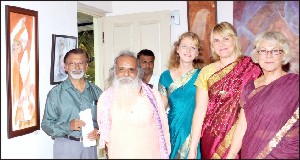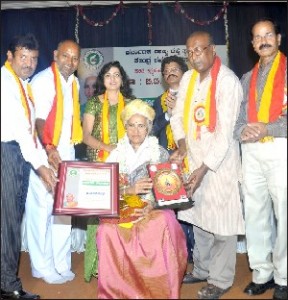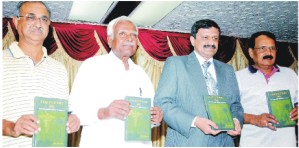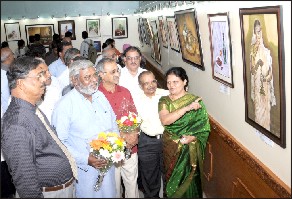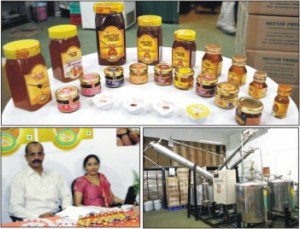Mysore:

A twin pack CD containing the compositions of H. Yoga Narasimham and a website about him were released on Oct. 16 at Rotary West audito-rium, in a function presided over by Dr. Padma Murthy who also released the CDs. Dr. Sukanya Prabhakar, who was present, spoke about the CDs and Dr. Mysore M. Manjunath released the website.
Mysore is a true cultural capital even from the days of Maharajas, who gave all-out support to fine arts like music, dance, drama, sculpture, painting etc. This was the main reason for many musicians of repute making this city as their home town. Many of them were composers too, like Veene Sheshanna, Mysore Sadashiva Rao, Mysore Vasudevacharya, Piteelu T. Chowdaiah, Muthaiah Bhagavatar to quote a few. One such composer was H. Yoga Narasimham (1897-1971), who pursued music throughout his life.
Yoga Narasimham was the youngest among the four children born to Narasappa and Lakshmidevamma and grew up in an atmosphere charged with music in the Palace and elsewhere. He was outstanding even in his academics. He had passed his BA exam with a gold medal in all the three subjects Sanskrit, English and Philosophy, in Maharaja’s College. He also completed his MA in Sanskrit from Mysore University.
He joined the Govt. of Mysore as Inspector of Schools under the Department of Schools and became the Principal of Sanskrit Maha Pathashala (Sanskrit College), Mysore. He retired as a District Education Officer, under Nalwadi Krishna Raja Wadiyar’s Royal Mysore Government.
His musical journey began at his home and the navigators were his mother, brothers and sisters. He also learnt a lot by listening to the great masters of the day. He became a disciple of Mysore Vasudevachar and was an ardent student of the legendary musician for seven years from 1928 to 1935. But their association continued for nearly four decades.
This made him a musician, composer, musicologist, critic, an author and editor of repute of musical works. But his composing ability came to the fore at the end of his life. He has composed only about 38 krutis, including Swara Jatis, Varnas, Krutis, Ragamalike, Padas, Javalis and Tillanas.
His compositions are in Sanskrit, Kannada and Telugu. They are a set of refined literary work of impeccable taste, and evolved with high musical acumen. Bharata Ratna M.S. Subbu Lakshmi sang and recorded some of his compositions in a cassette tape in 1986, which made the music fraternity to take notice of his krutis. She used to sing one his krutis in her concerts also and the most popular one was Sada Saranga Nayane in Raga Ranjini.
In spite of all this, the memory of music fraternity is short and his krutis would have gone to oblivion. Therefore, his daughter Neeraja Achuta Rao, a vocalist in her own virtue, her daughter M.A. Jyothi, a vocalist and violinist, brothers and sister of Neeraja took it upon themselves to preserve his krutis for the future and published them in a website www.devagitam.in. They also recorded 18 of krutis in two CDs. The website and CDs have been aptly named as Devagitam, as his Ankita (signature) was ‘Deva.’
The first CD contains ten krutis, Sundara Deva, a varna in Hin-dhola, Ekadantham Upasmahe (Begade-Adi), Kovaa Raago (Valachi-Mishra Jhampe), Sujana Charitam (Mukhari-Adi), Kaapaadade Nepa Hooduvee (Gagana Mohini-Adi), Nada Vara Sushobhitam (Nadavarangini-Khanda Triputa), Chandra Shekhara Guruvaram (Kamavardhini-Adi), More Ittarenu Idadiddarenu (Revathi-Khanda Chapu), Tillana (Abhogi-Khanda Triputa) and a Mangala Narasimhaya Mangalam (Madhyamavathi-Adi).
In the first CD, three krutis are sung by Neeraja and one solo is by Jyothi. The rest are sung by the duo. The two ragas in the above, Gagana Mohini and Nadavarangini are relatively new ones. The first one has a mention in the scripts and this is the only kruti available. The second one is a creation of Narasimham. Gagana Mohini has an Arohana Scale resembling Valachi and Avarohana resembling Amrutha Varshini. It is an Audhava Audhava Raga. The dominance of Kaishiki Nishadha in Arohana and Kakali Nishadha in Avarohana gives the raga its colour, but confuses as to which Janaka Raga it belongs. It can be said 64 Vachaspathi as its Janaka Raga. The other Raga Nadavarangini, a creation of the composer, is a Janya of 22 Kharahara Priya.
The second CD contains eight krutis, namely Kamala Mano Mohana, a Varna in Mohana set to Adi Tala, Shaanti Rupasyatam (Latantapriya-Adi), Sadaa Saaranga Nayane (Ranjini-Adi), Ninnu Minchina (Kolahala-Mishra Chapu), Saphalam Jeevitam (Kuntala Kusumavali-Adi), Hemateera (Kamboji-Khanda Triputa), Tillana (Kalyani-Adi) and Jaya Jaya Bharata (Ragamalike-Adi).
Jyoti has rendered seven krutis and the last one by Sahana Doravari, daughter of Jyoti and Arpita Somayaji, a student of Neeraja. Three Ragas Latantapriya, Kolahala and Kuntala Kusumavali are very rare Ragas. The first one Latantapriya is an Audhava Audhava Raga, a Janya of no. 1 Kanakangi. Most probably this is the only Kruti available in this Raga.
The second one Kolahala is a Vakra Shadhava Sampurna Raga, a Janya of 29 Shankarabharana. There are only three krutis available in this Raga, Madilona Jeevitham of Tyagaraja, Neerajaksha Maam Paahi of C. Rangaiah and the present one. It is heartening to see that the last two composers are from Mysore. The third one Kuntala Kusumavali is another Vakra Audhava Vakra Shadhava raga, a Janya of 65 Kalyani. Once again this may be the only composition available in this raga, as far as my knowledge goes.
The last Kruti is in Ragamalike (Madhyamavathi, Shuddha Dhanyasi, Mohana and Bilahari). It is a patriotic song, in praise of our National Flag and it has been rendered as group song. In both CDs, Charulatha Ramanujan and H.S. Sudheendra have accompanied on the violin and mrudanga respectively.
Most of the krutis are sung to showcase the wisdom of the composer in creating the Sahitya and its adaptation to a Raga. Neeraja Achuta Rao, the elderly lady, has retained the ability to sing. Jyoti is not only a vocalist, but also a violinist. Therefore she has imbibed many styles and has formed her own style of singing. She has rendered the compositions of her grandfather which was already set to tune. But her ability comes to fore when Manodharma can be used, like in Gagana Mohini, Kamavardhini, (both in first CD), Ranjini, Kamboji (both in second CD) where Alapane, Neraval and Swara Prasthara have been rendered.
The CDs have successfully brought out the beauty of the compositions written by Yoga Narasimham, who lived till the later half of the past century and many in my age group have seen and interacted with him. The listener is introduced to many new Ragas and rare ragas as well, in these CDs.
They also give good listening pleasure especially in Kamavardhini, Kamboji etc. Charulatha Ramanujam on violin and H.S. Sudheendra on mrudanga have given able support to the artistes. The digital recording of the CDs is neatly done by Resonators of Mysore. The set of two CDs is priced at Rs. 200.
A vocal concert by M.A. Jyothi, containing the compositions of Yoga Narasimham, had been organised at the end of the stage programme. She was accompanied by Adithi Krishna Prasad (violin), H.L. Shivashankara Swamy (mrudanga and S. Manjunath (ghata). The compositions she sang included five krutis from the CDs and two others.
The varna Kamala Mano Mohana (Mohana-Adi-CD 2), Sujana Charita Avadharaya Chitta (Mukhari-Adi-CD 1) and Kapadade Nepahooduve (Gagana Mohini-Adi-CD 1), were all replicas from the CDs.
Hema Teeradali (Kambodhi-Khanda Triputa-CD 2) was taken up elaborately with an Alapane of Kambodhi, which was followed on the violin neatly by Adithi. She took up a Neraval at the Anu Pallavi line Vamaanga Aalangita Padmalaya Priya Me Kalaya where her Manodharma was in fore, followed by Swara.
The next one was Nijada Nija Neenanate (Bhanu Dhanyasi-Khanda Chapu), a newly created raga, an offshoot of 45 Shubha Pantuvarali, with a limited Nishaadaantya Sanchara (S R G M N D N – D P M G R S N S). It has 5 single line Charanas. All the Charanas are sung the same way as the Pallavi line. Shubha Pantuvarali is a raga which evokes pathos. Therefore the effect is a little weary, as there is no variation and the repetition is also quick.
The concert concluded with a Tillana in Kalyani (CD 2) and a Mangala in Madhyamavathi (CD 1), composed on Lord Narasimha installed on the banks of River Hemavathi near Holenarasipur.
source: http://www.starofmysore.com / Feature articles / by S.R. Krishnamurthy
